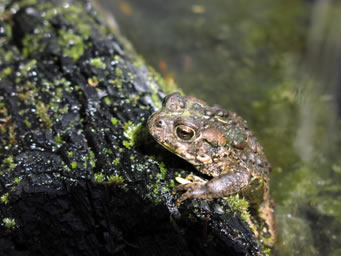 Rocky Mountain Research Station
Rocky Mountain Research Station
|
|
 Science Program Areas
Science Program Areas
|
|
 Hot Topics
Hot Topics
|
|
 Cross-Program Projects
Cross-Program Projects
|
|
 Research Laboratories
Research Laboratories
|
|
 Tools, Applications and Data
Tools, Applications and Data
|
|
 People
People
|
|
 About RMRS
About RMRS
|
|
 Contact RMRS
Contact RMRS
|
|
 Search
Search
|
|
 2009 Congressional Briefing
2009 Congressional Briefing
|
 RMRS Publications
RMRS Publications
|
 Experimental Forests
Experimental Forests
|
 Partnerships
Partnerships
|
 US Forest Service Links
US Forest Service Links
|
 RMRS Archives
RMRS Archives
|
|
|


|
|
Home > RMRS Archives > ScienceNow Archive > Wildfires & AmphibiansAre Wildfires Good for Amphibians?[POSTED 11/4/08]
Wildfires are increasing in frequency and severity—and that could be a bad thing for many sensitive species, including some amphibians. But a recent study of the effects of a severe burn on three species of pond-breeding amphibians determined that wildfires aren’t necessarily harmful to these species. Some—especially the boreal toad—like it hot. Amphibians are generally considered indicators of ecosystem health because they’re sensitive to disturbances. The loss or change of habitat is a leading cause of amphibian decline. But some species are resistant to disturbance or might even decline without it. Researchers are conducting studies to better understand how wildfires affect amphibians in the West. Most studies have addressed low-severity burns, but this one focused on the effects of a stand-replacement wildfire, which are difficult to measure because they are infrequent and not subject to experimental manipulation and control. In this case, the researchers had surveyed western Montana wetlands for breeding populations of the long-toed salamander, boreal toad, and Columbia spotted frog during the 3 years before part of their study area burned, presenting a rare opportunity to compare patterns in occupancy and colonization in burned and unburned wetlands after the fire. The results indicate that two of these species were not negatively affected, at least in the short-term, and one species—the boreal toad—seemed to benefit. Boreal toads colonized areas after the fire that they had not occupied before the fire. The researchers documented a similar pattern following another large wildfire 2 years later, with toads colonizing even more wetlands. After this second fire, radio telemetered boreal toads preferentially used severely burned habitats over partially burned habitats. Although these results agree with other studies that most amphibian populations are resistant to wildfire, some species are likely to experience at least short-term impacts. Further research is also needed to explore whether responses will differ in recently harvested forests or where the historic fire regime has been altered. In the meantime, at least some salamanders, frogs, and toads can enjoy the heat from wildfires. View the study: Responses of Pond-Breeding Amphibians to Wildfire: Short-Term Patterns in Occupancy and Colonization. |
Rocky Mountain Research Station
Last Modified: Tuesday, 16 December 2008 at 18:21:01 EST (Version 1.0.5)



